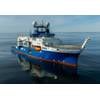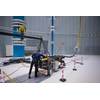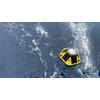The announcement from U.K. Prime Minister, David Cameron, urging Defense Chiefs to spend more on ‘readily deployable counter-terrorist capabilities’ such as unmanned aerial vehicles (UAVs), coupled with future acquisition programs such as the Type 26 Frigate and Maritime Underwater Future Capability (MUFC) is signaling a new era for the modern military battlespace. It is already widely accepted that unmanned systems act as significant force multipliers and are able to deliver capabilities at reach with greater flexibility and minimal human intervention.
In a bid to identify the significant opportunity of unmanned underwater, surface and air vehicles (UxVs), the Royal Navy will look to further demonstrate the potential capabilities, an initiative that will be jointly delivered through industry collaboration. Although the benefits of these systems are recognized, Craig Spacey, Head of Business Development - Submarines at BMT Cadence, a subsidiary of BMT Group Ltd, discusses the challenges ahead.
Force Multipliers
UxVs are effective ‘force multipliers’: a capability that, when added to and employed by a combat force, significantly increases the combat potential of that force and thus enhances the probability of successful mission accomplishment. Combined with pressure on defense budgets across the world, UxVs are now looking very attractive as their deployment reduces both the cost of the asset and the supporting supply chain. Furthermore, UxVs effectively remove the human element, both in terms of exposure of humans to risk and in terms of human error as a hazard during operation. This is particularly important during prolonged operations where operator fatigue would be detrimental to safe operation. The ability of UxVs to deliver repeatable and consistent performance is also desirable.
Unmanned Underwater Vehicles
Despite receiving less publicity than their airborne ‘cousins’, Unmanned Underwater Vehicles (UUV) have huge potential to deliver enhanced capabilities in the maritime domain. UUVs are a family of underwater vehicles including Remotely Operated Vehicles (both tethered and untethered) and Maritime Autonomous Systems (MAS): operating physically independent from other assets, (unlike the tethered Remotely Operated Vehicles prevalent in the offshore oil and gas industry), MAS have the potential to operate for prolonged periods over significant distance without the need for operator interaction. Interestingly, the success of the Unmanned Aerial Vehicle (UAV) is now having a positive effect on the way UUVs are viewed. Although much of the technology behind UUVs has been around for numerous years, UAVs have acted as technology and capability demonstrators in a very overt fashion to demonstrate what is possible in the unmanned field.
Development
While governments around the world have shown interest in the capabilities of UUVs, those without an in-house R&D capability have encouraged industry to do the leg-work and develop the technology. In the UK, the Ministry of Defense and Royal Navy have been very pragmatic in their outlook on UUVs by specifying capabilities that could be delivered by UUVs within projects such as the new Type 26 Global Combat Ship, without stipulating exactly how they should be delivered. This focus on capability has allowed industry to innovate with minimal constraints, which will undoubtedly deliver dividends in the long term.
Command & Control
Managing unmanned vehicles in the underwater space is arguably more challenging than in other domains. As well as working in three dimensions over large distances, there is the challenge of ensuring effective and secure command & control over an asset that is invisible to all but the most sensitive of sensing equipment. Another key area that is currently being researched is the launch and recovery of UUVs. While UAVs can take-off and land from unmodified aircraft carriers or other surface ships in the same way as traditional aircraft or helicopters, UUVs require modification, sometimes to a significant extent, to facilitate their safe launch and recovery. Furthermore, launch and recovery of a UUV from a submarine is a concept that will require specialist command & control and integration. The difficulties regarding the safe interaction of underwater assets has been addressed by BMT Cadence during the assessment of activities involving multiple manned and unmanned underwater assets on behalf of the MOD In-Service Submarine Team and rescue exercises involving the NATO Submarine Rescue System (NSRS). BMT Cadence’ sister company, BMT Designers & Planners has also done a large amount of work in developing launch and recovery systems for United States Navy and United States Coast Guard aircraft and vessels.
Safe Deployment
Before UUVs are deployed as more than just an R&D exercise there needs to be confidence that there are adequate safeguards in place to ensure that they won’t damage or harm any other ocean users that they may encounter during their deployment, or damage or harm the environment of the ocean itself. BMT Cadence is leveraging its breadth and depth of experience gained through its work on the safety assessment for the operation of manned and unmanned underwater assets, including submarine in-service support and Future Submarines programs for the UK MOD to ensure safe and environmentally responsible UUV operations.
The benefit that UUVs can deliver are being realized on both operational and financial levels. The Royal Navy’s Unmanned Warrior exercise planned for 2016 will see defense technology organizations demonstrate the deployment of combined UUVs (including MAS) concepts and will be a fascinating insight into how UUVs are developing. The ability to deploy this technology whilst keeping humans out of harm’s way and delivering capabilities that would cost billions of pounds using conventional forces certainly makes the UUV concept very appealing. The technology is available; the key now is to develop ways of ensuring that UUVs can interact with all the other stakeholders that use our oceans in a safe and environmentally responsible manner.
The Author
Craig Spacey is Head of Business Development - Submarines at BMT Cadence. Craig is responsible for identifying opportunities and partnerships in the delivery of services to those who build, maintain and sustain the UK’s Submarine capability, and is currently working on several projects, including Future Submarine, In-Service Submarines and the Submarine Dismantling project. As a Submarine Nuclear Engineer Officer in the Royal Navy, Craig gained experience managing and operating a Nuclear Submarine both globally and during deep maintenance activities.












 December 2025
December 2025



